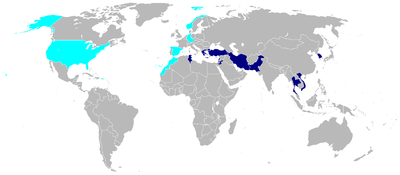M48 Patton
|
||||||||||||||||||||||||||||||||||||||||||||||||||||||||||
|
||||||||||||||||||||||||||||||||||||||||||||||||||||||||||
|
||||||||||||||||||||||||||||||||||||||||||||||||||||||||||
|
||||||||||||||||||||||||||||||||||||||||||||||||||||||||||
|
||||||||||||||||||||||||||||||||||||||||||||||||||||||||||
The M48 Patton was the third and final US medium gun tank of the Patton series[2], named after General George S. Patton, commander of the U.S. Third Army[3] during World War II and one of the earliest American advocates for the use of tanks in battle. It was a further development of the M47 Patton tank. The M48 Patton served as an interim tank until replaced by the US Army's first Main Battle Tank (MBT), the M60 Combat Tank.[3] The M48 served as the U.S. Army and Marine Corps's primary battle tank during the Vietnam War. It was widely used by U.S. Cold War allies, especially other NATO countries.
The M48 Patton tank was designed to replace the previous M47 Pattons and M4 Shermans. Although largely resembling the M47, the M48 Patton was a completely new tank design. Some M48A5 models served well into the 1980s. Many various M48 Patton models remain in service internationally. The M48 was the last US tank to mount the 90mm tank gun, with the last model, the M48A5, being upgraded to carry the new standard weapon of the M60, the 105mm gun.
The Turkish Army is the largest operator of the modernized M48 MBT, with more than 1,400 M48s in its inventory (around 1000 have been phased out/in storage or modified to ARVs).
Contents |
History

On 27 February 1951, OTCM #33791 initiated the design of the new tank, designated the 90mm Gun Tank T-48 (the prefix letter "T" would be replaced by the prefix "X" beginning with the M60 series tank).[4] A deeper modernization than the M46 and the M47, the M48 featured a new turret, new redesigned hull, and an improved suspension. The hull machine gunner position was removed, reducing the crew to 4. It was essentially a new tank . On 2 April 1953, the Ordnance Technical Committee Minutes (OTCM) order #34765 standardized the last of the Patton series tanks as the 90mm Gun Tank M48 Patton.[3]
Nearly 12,000 M48s were built from 1952 to 1959. The early designs, up to the M48A2C's, were powered by a gasoline 12 cylinder engine which was coupled with an auxiliary 8 cylinder engine (called the "Little Joe"). The gas engine gave the tank a short operating range and were prone to catching fire when hit. This version was considered unreliable but numerous examples saw combat use in various Arab-Israeli conflicts. They also were prone to fire when the turret was penetrated and the hydraulic lines ruptured spewing "cherry juice" (the nickname for the red colored hydraulic fluid) at high pressure into the crew compartment resulting in a fireball. The flashpoint was too low, less than 300 F, causing many burns and deaths to crew members. In 1959, American M48s were upgraded to the M48A3 model which featured a diesel power plant. M48s with gas engines, however, were still in use in 1975 by many West German Army units including the 124th Panzer Battalion.
M48A3
In February 1963, the US Army accepted its first of 600 M48 Patton tanks that had been converted to M48A3's, and by 1964, the US Marine Corps had received 419 Patton tanks. These Pattons were to be deployed to battle in Vietnam.[3]
M48A5
In the mid-1970s, the M48A5 upgrade was developed to allow the vehicle to carry the heavier 105mm gun. This was designed to bring the M48s up to speed with the M60 tanks then in regular use. Most of the M48s were placed into service with reserve units by this time.
By the mid-1990s, the M48s were phased out of U.S. service. Many foreign countries, however, continued to use the M48 models.
Combat service
Vietnam

The M48s saw extensive action during the Vietnam War, over 600 Pattons would be deployed with US Forces during the war.[5] The initial M48s landed with the US Marine 1st and 3rd Tank Battalions in 1965;[6] the Marine 5th Tank Battalion would later become a reinforcement unit. Remaining Pattons deployed to South Vietnam were in three U.S. Army battalions, the 1-77th Armor near the DMZ, the 1-69th Armor in the Central Highlands, and the 2-34th Armor near the Mekong Delta. Each battalion consisted of approximately fifty seven tanks. M48s were also used by Armored Cavalry Squadrons in Vietnam, until replaced by M551 Sheridan tanks. The M67A1 flamethrower tank (nicknamed the Zippo) was an M48 variant used in Vietnam.
The M48 Patton has the distinction of playing a unique role in an event that was destined to radically alter the conduct of armored warfare.[6] When US forces commenced redeployment operations, many of the M48A3 Pattons were turned over to the Army of the Republic of Vietnam (ARVN) forces, in particular creating the ARVN 20th Tank Regiment; which supplemented their M41 Walker Bulldog units. During the North Vietnamese Army (NVA) Easter Offensive in 1972, tank clashes between NVA T-54/PT-76 and ARVN M48/M41 units became commonplace. But on 23 April 1972, tankers of the 20th Tank Regiment were attacked by an NVA infantry-tank team, which was equipped with the new 9M14M Malyutka (NATO designation: Sagger) wire guided anti-tank missile. During this battle, one M48A3 Patton tank and one M113 Armored Cavalry Assault Vehicle (ACAV) were destroyed, becoming the first losses to the Sagger missile; losses that would echo on an even larger scale a year later during the Yom Kippur War in the Middle East in 1973.[6]

The M48s performed admirably[7] in Vietnam in the infantry-support role. However, there were few actual tank versus tank battles. One was between the 1-69th Armor and PT-76 light amphibious tanks of the NVA 202nd Armored Regiment near Ben Het in 1969[6]. The M48s provided adequate protection for its crew from small arms, mines, and rocket-propelled grenades. South Vietnamese M-48s and M-41s fought bravely in the defence of South Vietnam in the so called Ho Chi Minh Offensive in 1975. In several incidents, the South Vietnamese Army successfully defeated NVA T-34 and T-55 tanks and even slowed the North's offensive. However since the United States Congress passed bans on the transfer of fuel and ammunition to South Vietnam, the American-made tanks were soon out of ammunition and fuel and were abandoned to the North Vietnamese Army in 1975 which put them in predictably short service of the Vietnamese People's Army after the war ended in May 1975.
M48s, alongside Australian 20 pounder (84mm) gunned[8] Centurions of the 1st Armoured Regiment[6], were the only vehicles in Vietnam that could reasonably protect their crews from land mines. They were often used for minesweeping operations along Highway 19 in the Central Highlands, a two lane paved road between An Khe and Pleiku. Daily convoys moved both ways along Highway 19. These convoys were held up each morning while the road was swept for mines. At that time, minesweeping was done by soldiers walking slowly over the dirt shoulders of the highway with hand-held mine detectors. During this slow process, convoys would build up into a dangerously inviting target for the enemy. As a result a faster method was improvised. One M48 lined up on each side of the road, with one track on the dirt shoulder and the other track on the asphalt; then they raced to a designated position miles away. If M48s made it without striking a mine, the road was clear and the convoys could proceed. In most cases, an M48 that struck a land mine in these operations only lost a road wheel or two in the explosion; seldom was there any hull damage which would be considered "totaling" the tank.[8]
Indo-Pakistani Wars
M47s and M48s were again used in tank warfare by the Pakistan Army against Indian Army's Centurion and M4 Sherman tanks in the Indo-Pakistani War of 1965 with some good results. In the Rann of Kutch the tanks proved surprisingly nimble in marshy terrain, and Pakistani forces drove back Indian incursions. In Kashmir and Punjab, the tank had its first real test. During Operation Grandslam, Pakistani tank forces broke through the Indian lines very quickly, and defeated armored counterattacks. The Pakistanis used approximately a division worth of tanks though not all were Pattons. The Patton failed to live up to expectations in the Battle of Asal Uttar, where about 97 Pakistani tanks were lost majority of them being Pattons. Later the tank was the main Pakistani tank at the Battle of Chawinda and its performance at that battle was deemed satisfactory.The Patton was later used by Pakistan in the Indo-Pakistani War of 1971, with mixed results. In a repetition of 1965, Pattons spearheaded the Pakistani advance through Chamb, and the Patton was the main Pakistani tank at Shakarghar. In the latter battle, a brigade of tanks (the Changez Force) successfully resisted the Indian advance, in a repeat of Chawinda. However, in what became known as Pakistan's Charge of the Light Brigade, a counterattack led by 13th Lancers and 31st Cavalry was mauled by the Indian 54th Division around Battle of Barapind. India later set up a war memorial named "Patton Nagar" ("Patton City") in Khemkaran District, where the captured Pakistani Patton tanks are displayed.
Analyzing their performance, the Pakistani Army held that the Patton was held in reasonably high esteem by both sides and that tactics were to blame for the debacle at Asal Uttar [9]. However, a U.S. study of the battles in South Asia concluded that the Patton's armor could in fact be penetrated by the 20 pounder gun (84mm) of the Centurion as well as the 75mm gun of the AMX-13.
Middle East
M48s were also used with mixed results during the 1967 Six-Day War. On the Sinai front, Israeli M48s up-gunned with 105mm L7 rifled guns were used with success against Egyptian T-34s and SU-100s supplied by the Soviet Union in the second battle of Abu-Ageila. However, on the West Bank front, Jordanian M48s were often defeated by Israeli WWII-era M4 Shermans (up-gunned with 105mm guns). In pure technical terms the Pattons were far superior to the Shermans, with shots at more than 1,000 meters simply glancing off the M48s' armor; However the 105mm gun the Israeli Shermans used was designed to defeat the T-62 tank which was the Soviet response to the M48's successor in US service, the M60. The Jordanian Pattons' failure on the West Bank could also be attributed to Israeli air superiority. The Israeli Army captured about 100 Jordanian M48 and M48A1 tanks and pressed them into service in their own units after the war.
M48s were used by the Lebanese Army and the Christian Lebanese Forces militia in the Lebanese Civil War. The Lebanese Army still operates about 100 M48s. In 2007, during the 2007 North Lebanon conflict Lebanese Army M48s shelled militant outposts in a refugee camp.[10]
Although only the M-47s were actively deployed in the Operation Attila I&II in July and August 1974, M-48s are later stationed in Cyprus by Turkish Armed Forces.
Africa
Pakistan used M48 Pattons while rescuing American troops during the Battle of Mogadishu in 1993.
Variants
U.S. variants

- M48: Differed from the M47 in having yet another new turret design and a redesigned hull, doing away with the bow machine gun position, featuring the M41 90 mm gun. These turrets give the M48 its distinctive non-M26 style look. Originally the gun featured a Y-shape muzzle brake, but this was changed to the more characteristic T-shape.
- M48C: Over a hundred original production hulls were found to be lacking correct ballistic protection and were relegated to training as the M48C.
- M48A1: New driver hatch and M1 commander's cupola, allowing the M2HB .50 caliber machine gun to be operated and reloaded from within the vehicle.
- M48A2: improved powerpack and transmission, redesigned rear plate, an improved turret control.
- M48A2C: M48A2s with an improved rangefinder, M17, new ballistic drive and bore evacuator for the main gun, and the auxiliary tensioning wheels were deleted.
- M48A3: Refit of M48A1s with diesel engines and a new fire control system.
- M48A3 Mod. B: Additional armor on the exhausts and tail lights, and a raised commanders cupola.
- M48A4: Proposed refit of M48A3s with M60 turrets, scrapped with the need of these previous "surplus" turrets with the failure of the M60A2
- M48A5: Up-gunned with the 105 mm M68 gun.
- M48A5PI: M1 cupola replaced by the Israeli Urdan model.
- M67 "Zippo": M48 armed with a flamethrower inside a dummy model of the main gun with fake muzzle brake. Named after a popular brand of cigarette lighter.
- M67A1: M67 variant, M48A2 hulls used.
- M67A2: M67 variant, M48A3 hulls used.
Specialized variants
- M8: Bulldozer and earthmoving equipment for the M48.
- M8A1: Improved bulldozer and earthmoving equipment for the M48
British variant
- M48 Marksman: A SPAAG version, equipped with a Marksman turret.
Israeli variants
Israel created an extensive number of variants of the series from tanks acquired initially from a number of sources, including capturing them in battle, or from other countries such as Germany and the United States. Many of the Israeli M48's have been upgraded with additional reactive or passive armor, drastically improving their armor protection. These uparmored versions are called Magach.
- E-48
- E-48 AVLB: A M48 AVLB but with an Israeli bridge.
- E-48 (M48A2): An unmodified M48A2 from Germany.
- E-48 (M48A2C): German designation for the M48A2C.
- E-48 (M48A3): US-made M48A3 in German service.
- Magach: A series of improved Israeli versions of the M48 and the M60.
Jordanian variants
- AB1: Jordanian armoured recovery vehicle.
- AB9B1: Jordanian upgrade with a 120 mm smoothbore main gun.
Republic of China (Taiwan) variants
- M48A3 (ROC Variant): Most of Republic of China Army M48A3 began their lives as M48A1/A2 and have (unlike those serving other nations) retained the original engine compartment, the engine installation made possible by removing adjacent fuel cells, resulting in a lower operational range of 312 km.
- M48H/CM-11 "Brave Tiger": ROC version consisting of an up-gunned M48A2 turret and a M60A3 hull. Also has significant upgrades to the gun tracking equipment and fire control.
- CM-12: M48A3 retrofitted with the same weapons and fire control upgrades as the CM-11. They retained the original engine compartment of the M48A1/A2, and the upgrade apparently again included the removal of some fuel cells in the hull, resulting in a lower operational range than that of the M48A5 (the official figure being 203 km).
Hellenic variants
- M48A5 MOLF: The Hellenic Army has added the EMES-18 FCS to their M48A5, denumerating them as "MOLF" for Modular Laser Fire Control System.
Spanish variants

- M48A5E: M48A5 variant, 105 mm gun with laser rangefinder.
- Alacran CZ-10/25E: Spanish Army combat engineer variant.
- Alacran CZ-10/30E: Upgraded CZ-10/25E.
South Korean variants
- M48A3K: This variant uses a diesel engine instead of the original gasoline type. Other changes include installation of a T-shaped muzzle brake on the gun, three additional support wheels on the tracks, commander's periscope on the turret and smoke grenade dischargers. The fire control system has also been replaced with a native South Korean version.
- M48A5K: Replacing the main gun with the KM68 105 mm gun. Additional side skirts were provided, and the fire control system was upgraded to the Laser Tank Fire Control System (LTFCS).
Turkish variants
- M48A5T1: Turkish M48 variant upgraded along similar lines to the M48A5, with an M68 105 mm main gun, passive night vision and an MTU diesel engine.
- M48A5T2: Improved version of the M48A5T1 with thermal imaging and a laser rangefinder.
- M48T5 "Tamay" ARV: Turkish-designed armored recovery vehicle built on the M48 chassis.
German variants

- Minenraeumpanzer Keiler: An armored mine flail, mine clearing vehicle based on a widely modified M48A2C cast hull. This vehicle remains in service.
- Kampfpanzer M48A2C: Served together with the M47 starting in the late 1950s (the M47 was replaced by the Leopard 1). When the Leopard 2 came into service they were sent to the Heimat-Schutzbrigaden ("home defence brigades") of the Territorialheer (Territorial Army). Many were later upgraded to M48A2GA2 standard.
- Kampfpanzer M48A2GA2: Upgraded version with the 105 mm L7 cannon and a different MG3 installation from the Leopard 1 as well as quite a few other assemblies. The tank served with tank battalions and in the 5th (heavy) company of some Jäger Battalions of the Territorial Army.
- Combat-Engineer Variants: The Bundeswehr used several Combat Engineer Variants of the M48. The early versions were based on the M48A2C with an M8 dozer blade attached but otherwise unmodified vehicles. When the M48 was upgraded to the M48A2GA2, these tanks were not upgraded but rather lost their gun completely.
- Super M48[11]: Private venture upgrade for the M48. Featured a 105 mm L7 cannon, a new Diesel engine and add-on armor on the turret front.[12] Never developed beyond a prototype/test platform stage.
Operators

 Iran: 80.
Iran: 80. Israel: 561 Magach 5 Golan.[13]
Israel: 561 Magach 5 Golan.[13] Jordan: 200.
Jordan: 200. South Korea: 380 M48A3K and 500 M48A5K (being replaced with K2 Black Panther).
South Korea: 380 M48A3K and 500 M48A5K (being replaced with K2 Black Panther). Lebanon: 104 M48A1 (retired) and M48A5 tanks.
Lebanon: 104 M48A1 (retired) and M48A5 tanks. Pakistan: 345 M48A5.
Pakistan: 345 M48A5. Republic of China: 450 CM-11, 100 CM-12.[14]
Republic of China: 450 CM-11, 100 CM-12.[14] Thailand: 150 M48A5.
Thailand: 150 M48A5. Vietnam: 20 M48s, some in reserve.
Vietnam: 20 M48s, some in reserve. Morocco: 300 M48A5.
Morocco: 300 M48A5.
Former operators
 Greece: 390 M48A5 MOLF (being retired).
Greece: 390 M48A5 MOLF (being retired). Lebanon
Lebanon Norway: 38 M48A5.
Norway: 38 M48A5. Portugal: 86 M48A5.
Portugal: 86 M48A5. South Vietnam: 20 (passed on to Socialist Republic of Vietnam).
South Vietnam: 20 (passed on to Socialist Republic of Vietnam). Spain: 164 M48A5E.
Spain: 164 M48A5E. Tunisia: 28.
Tunisia: 28. Turkey: 1369 T1 + 760 T2 variants to be gradually phased out and replaced by M60T, Leopard-1T and the Altay tanks.
Turkey: 1369 T1 + 760 T2 variants to be gradually phased out and replaced by M60T, Leopard-1T and the Altay tanks. United States
United States West Germany
West Germany Yugoslavia
Yugoslavia
See also
- T-54
- M46 Patton
- M47 Patton
- Type 61
- M60 Patton
- M88 Recovery Vehicle - An armored recovery variant based on the M48 Patton/M60 Series tanks chassis and part of the automotive component.
- M103 heavy tank
- List of armoured fighting vehicles
- G-numbers - SNL G254
References
- ↑ Hunnicutt P.35
- ↑ although the Ordnance Committee Minutes/OCM #33476 ceased utilizing the heavy, medium, and light tank designations on 07 November 1950; going to the "...Gun Tank designation")
- ↑ 3.0 3.1 3.2 3.3 Hunnicutt
- ↑ Hunnicutt/p. 85 & 152
- ↑ Starry/Hunnicutt
- ↑ 6.0 6.1 6.2 6.3 6.4 Dunstan
- ↑ Nolan
- ↑ 8.0 8.1 Starry
- ↑ Pakistan Military Consortium :: www.PakDef.info
- ↑ [1]
- ↑ Super M48
- ↑ Information on Jane's about the Super M48
- ↑ Israel - Army Equipment
- ↑ Taiwan - Army Equipment
Bibliography
- Steven J Zaloga, Tony Bryan, Jim Laurier - "M26–M46 Pershing Tank 1943–1953", 2000 Osprey Publishing (New Vanguard 35), ISBN 1-84176-202-4.
- Keith W. Nolan "Into Lao's, Operation Lam Son 719 and Dewey Canyon II" 1986. Presidio Press. Account of the US Army's final offensive of the Vietnam War.
- Abraham Rabinovich - "The Battle for Jerusalem June 5–7, 1967", 2004 Sefer Ve Sefer Publlishing, Jerusalem, ISBN 965-7287-07-3
- Starry, Donn A., General. "Mounted Combat In Vietnam"; Vietnam Studies. 1989; Department of the Army.
- Hunnicutt, R. P. "Patton: A History of the American Main Battle Tank." 1984, Presidio Press; ISBN 0-89141-230-1.
- Dunstan, Simon. "Vietnam Tracks-Armor in Battle." (1982 edition, Osprey Publishing), ISBN 0-89141-171-2.

